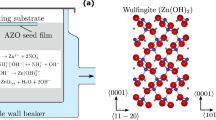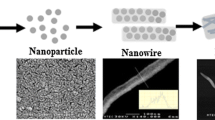Abstract
ZnO nanowires have been grown by chemical vapour deposition (CVD) using PdZn bimetallic nanoparticles to catalyse the process. Nanocatalyst particles with mean particle diameters of 2.6 ± 0.3 nm were shown to catalyse the growth process, displaying activities that compare well with those reported for sputtered systems. Since nanowire diameters are linked to catalyst morphology, the size-control we are able to exhibit during particle preparation represents an advantage over existing approaches in terms of controlling nanowire dimensions, which is necessary in order to utilize the nanowires for catalytic or electrical applications.
(See supplementary material 1)
Similar content being viewed by others
Owing to the large variety of morphologies reported, the possibility of synthetically fine-tuning their structure and their documented application in chemical and electrical devices, nanowires have come to represent a major field of research interest in recent years [1, 2]. Among the features that can be synthetically controlled, variation of the crystal structure is particularly important by virtue of its role in defining manifold electronic properties.
Compared to nano particulate systems, the length of as-grown nano wires may be large relative to the nanoscale. This implies anisotropies in terms of properties, whereby there may be only two quantum-confined and one non-quantum-confined dimension manifest in the system. It is in this context that metal oxide, and especially wide band-gap semiconductors like zinc oxide, have become popular for, amongst other reasons, their possible applications in optoelectronics.
In spite of a profusion of early experiments with magnetron sputtering [3], hydrothermal [4] and melt growth [5] having been reported, vapour phase techniques have become increasingly widespread for the synthesis of ZnO nanostructures of defined shape and size [6]. The structural sensitivity of the resulting nanostructures with regard to the specific conditions of the technique and the experimental parameters has led to the results reported in the literature so far revealing quite diverse architectures. Metal organic CVD (MOCVD) has, for instance, proved to be a successful route by which to grow high-quality and structurally reproducible nanowires through the deployment of zinc acetylacetonate as a precursor [7]. Accordingly, the ease of use of this substrate and the extensive previous investigations reported into the experimental parameters affecting the growth behaviour induced by it by Dalal et al., have led to a vapour deposition method using a ZnO/graphite powder substrate being utilized for the present study [6]. Using this method, both monometallic and a variety of bimetallic nanoparticles have already been studied for their catalytic properties in nanowire growth [8, 9]. In previous experiments, however, the method of catalyst deposition, mostly itself performed by evaporation or sputtering of a very thin layer under high vacuum, has required expensive and demanding equipment. Furthermore, due to there having been a lack of capping agents present, sputtered metal particles have tended to agglomerate in order to reduce their overall surface energies. Consequently, polydispersed particles have hitherto resulted [10]. From this point of view, it is clear that particles synthesized by wet chemical routes may offer significant advantages, as their characteristics are not limited to the restrictions inherent in the PVD process. This has led us to extend our previous research on the versatile catalytic properties of PdZn nanoparticulates [11].
Both titanium and stainless steel TEM sample grids were first TiO2 coated by either dip or droplet coating with a Ti(iOPr)4 solution and subsequently calcined under air at 500°C (see below). The prepared grids were dip coated with a methanol suspension of PdZn colloid (molar metal ratio 50:50) with a total metal concentration of 0.490 mg/ml. As a control sample, a silicon wafer was coated with particles under the same conditions, but without having been previously TiO2-coated, since highly polished Si supports are known to be inactive in the CVD growth of ZnO nanostructures [12]. CVD was then carried out in a quartz tube inside a Carbolite furnace for 30 min at temperatures ranging from 560 to 820°C. An Ar/O2 mixture was used as the carrier gas. Subsequent analyses were carried out by both HRSEM and HRTEM along with EDS and SAED.
An overview of the parameter combinations investigated is shown in Table 1. Selected images for titanium grids at 680 and 820°C and for stainless steel grids at 640 and 760°C are shown in Fig. 1. In all of these cases, initial colloid metal concentrations of 0.490 mg/ml were chosen for the catalyst coating.
Representative SEM (left) and TEM (right) images of samples a 2 (stainless steel grid, dip coated, deposition temp. 640°C), b 9 (stainless steel grid, droplet coated, deposition temp. 760°C), c 11 (Ti grid, droplet coated, deposition temp. 680°C), d 12 (Ti grid, droplet coated, deposition temp. 820°C), e Si reference wafer, spin coated. c(cat) = 0.490 mg/ml (see Electronic Supplementary Information)
As Fig. 1 shows, the chosen nanocolloid concentration of 0.490 mg/ml turned out to be highly active in promoting the catalytic growth of ZnO nanostructures. SEM and TEM analyses revealed a wide structural diversity in the resulting materials for the selected temperature and pressure parameters. In agreement with findings previously reported by the authors [6], a variety of morphologies formed in parallel with nanowires of homogeneous morphology. Examples include three-dimensional nanoscale structures that constitute a near-continuous layer (Fig. 1c), two-dimensional nanobelts and nanoribbons (Fig. 1b) or one-dimensional nanowires (Fig. 1d).
As the representative selected-area diffraction pattern shown in Fig. 2 demonstrates the nanowires produced in this work have grown in the hexagonal wurtzite form of zinc oxide in all investigated cases. Interestingly, for both grid materials tested, experiments conducted at deposition temperatures of below 700°C yielded nanowires whose tips were capped by droplet structures (e.g. Fig. 1a, 1c). We take this to be indicative of a vapour-liquid–solid (VLS) growth mechanism [13]. Such an observation is interesting insofar as this mechanism, although common when different growth techniques are employed, has not previously been observed for the experimental conditions deployed here. Repeated attempts have been made to investigate the nature and composition of the wire tip areas in order to establish the presence of palladium. However, these have proved unsuccessful to date. Ongoing work is seeking to overcome this limitation by deploying a higher resolution EDS system.
The observation of ZnO nanomaterials that exhibit a partly randomized morphology in conjunction with high structure densities when compared to the results of experiments conducted using different catalysts, such as Au [6], supports the conclusion that the presently employed PdZn systems represent highly active growth catalysts. Furthermore, our results confirm previous investigations by Dalal et al., who pointed out the importance of parameters such as the oxygen partial pressure, the system pressure, the deposition temperature and the catalyst layer thickness in playing a crucial role in defining the specifications of the resulting nanowires in terms of their diameters and areal densities.
The best results reported here were achieved using a droplet-coated Ti grid and subsequent deposition at 820°C to produce one-dimensional nanowire structures, which are morphologically homogeneous compared to different growth conditions (sample 12, Fig. 1d). In comparison, the corresponding stainless steel grid produced predominantly two-dimensional nanobelt structures under otherwise identical conditions (Electronic Supplementary Information). Using the same coating method, a stainless steel grid gave comparable wire structures at 760°C (sample 9, Fig. 1b), showing that the support metal must have an as yet unknown electronic influence on the particles, the nature of which is the subject of ongoing study. In this regard, our results seem to confirm the general trend, whereby higher temperatures allow greater morphological control over the formation of homogeneous wire structures as reported by Choy et al. [14, 15]. Using atomic layer deposition (ALD), the authors reported preferential growth of wires along the wurtzite c-axis at temperatures of 280°C, with polycrystalline products being preferred at lower temperatures.
In conclusion, we have demonstrated the high activity of PdZn nanoparticles in the CVD growth of zinc oxide nanowires. We have also shown that, using otherwise identical experimental conditions, the choice of both support metal and deposition temperature is of crucial importance for the resulting nanostructure morphology. On either grid material, and irrespective of coating method, increased temperatures tended to yield more one-dimensional and morphologically homogeneous structure types. Thus, ZnO growth on titanium supports at 820°C gave only homogeneous one-dimensional nanowires (sample 12, Fig. 1d). Ongoing work seeks to develop control over all parameters that influence nanowire morphology, including catalyst dimensions and composition. The present research demonstrates that an efficient ZnO nanowire growth catalyst can be generated without the need for high vacuum equipment. The refinement of precise control over nanocatalyst dimensions, defect density, structure and composition promises applications in the commercial manufacture of catalysts for the development of new ZnO nanowire devices.
References
zgr U, Alivov YI, Liu C, Teke A, Reshchikov MA, Doğan S, Avrutin V, Cho SJ, Morko H: J. Appl. Phys. 2005, 98: 103. 041301 041301
Wang ZL: J. Phys. Condens. Matter. 2004, 16: R829-R858. COI number [1:CAS:528:DC%2BD2cXmtVyhtLY%3D]; Bibcode number [2004JPCM...16R.829W] COI number [1:CAS:528:DC%2BD2cXmtVyhtLY%3D]; Bibcode number [2004JPCM...16R.829W] 10.1088/0953-8984/16/25/R01
Srivastava AK, Chakraborty B.R, Chandra S, Nanomater J 2009, 5. 310360
Lepot N, Van Bael MK, Van den Rul J, D’Haen J, Peeters R, Franco D, Mullens J: Mater. Lett.. 2007, 61: 2624–2627. COI number [1:CAS:528:DC%2BD2sXksFaqsbk%3D] COI number [1:CAS:528:DC%2BD2sXksFaqsbk%3D] 10.1016/j.matlet.2006.10.025
Kim IS, Lee GH: Solid State Commun.. 2002, 123: 191–193. COI number [1:CAS:528:DC%2BD38XlvVSnsLo%3D]; Bibcode number [2002SSCom.123..191K] COI number [1:CAS:528:DC%2BD38XlvVSnsLo%3D]; Bibcode number [2002SSCom.123..191K] 10.1016/S0038-1098(02)00299-5
Dalal SH, Baptista DL, Teo KBK, Lacerda RG, Jefferson DA, Milne WI: Nanotechnology. 2006, 17: 4811–4818. COI number [1:CAS:528:DC%2BD28Xht1Klt7vI]; Bibcode number [2006Nanot..17.4811D] COI number [1:CAS:528:DC%2BD28Xht1Klt7vI]; Bibcode number [2006Nanot..17.4811D] 10.1088/0957-4484/17/19/005
Kashiwaba Y, Haga K, Watanabe H, Zhang BP, Segawa Y, Wakatsuki K: in 10th international conference on II-VI compounds. 2001, 921–924. Wiley, Bremen Wiley, Bremen
Chen JY, Pan CJ, Tsao FC, Kuo CH, Chi GC, Pong BJ, Chang CY, Norton DP, Pearton SJ: Vacuum. 2009, 83: 1076–1079. COI number [1:CAS:528:DC%2BD1MXjt1Sntbs%3D] COI number [1:CAS:528:DC%2BD1MXjt1Sntbs%3D] 10.1016/j.vacuum.2009.02.001
Li SY, Lee CY, Tseng TY: J. Cryst. Growth. 2003, 247: 357–362. COI number [1:CAS:528:DC%2BD38XptlWhur8%3D]; Bibcode number [2003JCrGr.247..357L] COI number [1:CAS:528:DC%2BD38XptlWhur8%3D]; Bibcode number [2003JCrGr.247..357L] 10.1016/S0022-0248(02)01918-8
Moshfegh AZ: in international workshop on physics and technology of thin films. Edited by: eds. A.Z. Moshfegh, H.V. Kanel, S.C. Kashyap, M. Wuttig. World Scientific Publ Co Pte Ltd, Tehran, 2003; 2003:28–53. IWTF IWTF
Engels V, Wheatley AEH, Berengeur-Murcia A, Jefferson DA, Johnson BFG: Mater. Sci. Forum. 2009, 604–605: 13–17.
Geng CY, Jiang Y, Yao Y, Meng XM, Zapien JA, Lee CS, Lifshitz Y, Lee ST: Adv. Funct. Mater.. 2004, 14: 589–594. COI number [1:CAS:528:DC%2BD2cXlslajsbg%3D] COI number [1:CAS:528:DC%2BD2cXlslajsbg%3D] 10.1002/adfm.200305074
Pfeiler W: Alloy physics: a comprehensive reference. Wiley, Weinheim; 2007.
Choy KL: Mater. World. 2003, 11: 31–33. COI number [1:CAS:528:DC%2BD3sXltFahtbw%3D] COI number [1:CAS:528:DC%2BD3sXltFahtbw%3D]
Pung SY, Choy KL, Hou X, Shan C: Nanotechnology. 2008, 19: 8. 435609 435609
Acknowledgments
The authors would like to acknowledge the European Commission (NOE EXCELL NMP3-CT-2005-515703, Volker Engels) and the Nokia Research Centre Cambridge, UK, through the NRC/Cambridge University Framework Research Agreement Project on Large Area Sensing Surfaces (Aron Rachamim, Sieglinde Pfaendler and Sharvari Dalal).
Open Access
This article is distributed under the terms of the Creative Commons Attribution Noncommercial License which permits any noncommercial use, distribution, and reproduction in any medium, provided the original author(s) and source are credited.
Author information
Authors and Affiliations
Corresponding author
Electronic supplementary material
11671_2010_9567_MOESM1_ESM.docx
Electronic supplementary material: The online version of this article (doi:10.1007/s11671-010-9567-4) contains supplementary material, which is available to authorized users. (DOCX 6 MB)
Rights and permissions
Open Access This article is distributed under the terms of the Creative Commons Attribution 2.0 International License (https://creativecommons.org/licenses/by/2.0), which permits unrestricted use, distribution, and reproduction in any medium, provided the original work is properly cited.
About this article
Cite this article
Engels, V., Rachamim, A., Dalal, S.H. et al. Nanoparticulate PdZn as a Novel Catalyst for ZnO Nanowire Growth. Nanoscale Res Lett 5, 904 (2010). https://doi.org/10.1007/s11671-010-9567-4
Received:
Accepted:
Published:
DOI: https://doi.org/10.1007/s11671-010-9567-4






